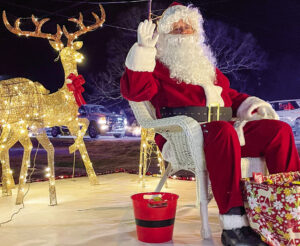Embrace whimsy with special outdoor space for fairy folk
One way some people are having fun this spring is by creating fairy gardens or adding to fairy gardens they have already.
A fairy garden, for the uninitiated, is a decorative, miniature garden usually grown in a container or other small space. These “magical” gardens are filled with small plants and accessories. Whether the creator chooses to add fairies of their own or leave the garden vacant to attract “real” fairies to visit, these whimsical creations provide a special outlet for creativity.
“I have an eclectic fairy garden full of fairies, gnomes, gnome homes, stairs and a variety of other tiny items,” said Chyrel Hampton. “I even have mummies and skeletons scattered around.”
Hampton’s fairy garden is built along an old retaining wall near her home.
“My grandkids like to take the pieces out and play in the dirt with them and return them wherever they will,” she said. “Nothing ever gets put back the same way, and that’s part of the fun of it.”
Hampton said a fairy garden is an amusing and relaxing way to enjoy time together without spending a lot of money. Some of her fairy garden décor includes rocks her grandchildren painted. Inexpensive pieces are readily available for purchase, as well.
Tips for getting started
1. Begin with an inexpensive pot or other container or place the items directly into the dirt, perhaps near a tree or other item of interest. If using a container with real plants, make sure it has proper drainage, with holes in the bottom of the container as well as a layer of small stones.
2. Add a layer of potting soil.
3. Add plants and bigger items and fill the rest of the space with smaller pieces, leaving room for adding more elements later.
4. Consider how much sun the plants need. Make sure to think about whether they are indoor or outdoor plants.
5. Some people include fairy figurines in their gardens, while others only provide a nice spot for fairies to find and enjoy.
6. Buy tiny items from dollar stores, many of which offer an inexpensive variety of pieces.
7. Make items to include, if you want to go that route. Lots of inspiration and specific suggestions are freely available on websites like Pinterest and YouTube.
Candy Hunter said she thought it would be fun for her sons to help create a fairy garden. They used dollar store items along with a wooden box built by their grandfather, adding dirt, sand and gravel as well as succulents, a type of plant that is easy to maintain.
“The plants were on clearance, and I used E6000 and hot glue to attach Popsicle sticks to each piece of fairy furniture to help them stand upright in the dirt, Hunter said. “It was inexpensive and a lot of fun.”
Megan Skidmore, another fairy garden enthusiast, advises starting small and using as many natural elements as possible, including a variety of pieces and plants at different heights. “I love to have Gerber daisies and impatiens in mine,” Skidmore said. “I enjoy going to the garden section and getting the saddest looking flowers and putting them in the garden for the fairies to fix.”
Mandy Martin and her daughter opted to create a fairy garden in their little red wagon.
Lela Ray said her garden has been put away for winter but will soon reappear with the onset of spring, adding, “The fairies will return when the butterflies do.”










